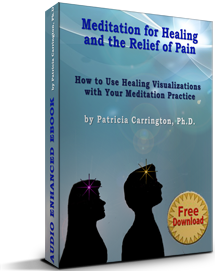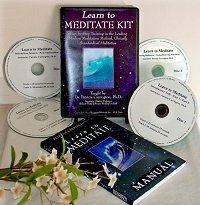Dr. Patricia Carrington's award winning meditation technique CSM (Clinically Standardized Meditation) is a clinically sensitive meditation method developed by the Medical Department of New York Telephone Company and used by numerous medical institutions, organizations, and individuals worldwide. For information click here.
The Mystery of the Mantra
Traditional Uses of Mantras
Patricia Carrington, Ph.D.
Author of “The Book of Meditation”
Those of us in the field of meditation are still unable to answer many of the questions that are asked of us about the use of sound and mantra and therefore have to refer to teachers of the great meditative traditions who are expertly trained in the ancient art of mantra. Traditional wisdom can tell us much that is of use today.
Mantras are used by a variety of ancient spiritual traditions, all of which carefully specify the ways in which they must be employed. According to Yogic tradition, proper use of the mantra rests on a number of conditions which cannot readily be met in Western life. Each mantra is traditionally analyzed by the master or ‘guru’ who dispenses it according to the sounds used in producing it and the parts of the body or energy system these particular sounds vibrate. The sound frequencies at which the mantra is transmitted are said to determine whether higher or lower portions of a particular energy center (or chakra) will be affected. Yogic tradition stresses the fact that this process depends for its effectiveness on the tonality of the teacher’s voice when imparting the mantra, as well as the pupil’s ability to reproduce that tone – out loud in the beginning, and later on in the mind.
The instantaneous effect which a correctly pronounced mantra can produce depends on the master’s skill. An exact and even inspired intoning of the mantra is apparently required to put ‘life’ into the sound. Whatever secret there is in the mantra seems to lie in how it is chanted. The word alone is considered to be barren, much like musical notation which remains mechanical and empty until enlivened by the feelings of a musician. Just as notes of the scale played by a beginner on the violin differ from those same notes played by a virtuoso, so the effect of the mantra differs according to whether it is conveyed by a well-meaning neophyte or by a person who, with many years of practice, has mastered the particular sound to be produced.
Such a skill is difficult to find even in India. While there are many students of the Mantra Shastras (Hindu scriptures describing the mantras) who understand their use, very few of them are thought to know how to intone these mantras properly. Even an expert may learn to pronounce only a few of them in a lifetime. Since there is no notation system which conveys their pronunciation, the ‘notation’ remains in each master’s head, passed down over generations by word of mouth.
A close relationship between master and pupil forms the basis for the assignment of a traditional mantra by a teacher to suit his particular student at a particular stage in that student’s spiritual development. The mantra may later be changed a number of times to correspond to the student’s advancing spiritual growth. Since a mantra is assigned only after careful examination of the disciple and an exhaustive study of his condition, such precision cannot be duplicated by relying on general information such as a person’s age, sex or socioeconomic status when determining the choice of a mantra, even though this is done by some contemporary meditation training systems.
I always advise people to be cautious about claims made by any large meditation organization that they can impart a ‘personal’ mantra to a trainee. This is not possible unless there is an ongoing and very close relationship between teacher and pupil, even though the large organizations may be helpful to a modern meditator in other ways.
The Sanskrit word ‘mantra’ actually means, ‘that which liberates the mind’.1 In India mantras whose specific effects are known have been authenticated by highly trained practitioners over a period of several thousand years. Sri Shyam Bhatnagar, an internationally recognized master of sound and mantra who has been teaching his method of therapeutic sound in the United States and Europe for over three decades, indicates that in the Indian tradition, certain mantras represent the nature or innermost qualities of various energies or ‘deities’ that reside within us.2 These energies are said to be evoked by properly repeating the mantra, which is often, though not always, the name of a deity. The concept that the power of a deity resides in its name is also embraced by the Judeo-Christian and Moslem traditions where the name of the Lord is looked upon as so sacred as to be unspeakable, or only to be repeated under special circumstances, because it embodies the very spirit of God.
Sri Bhatnagar also points out that mantras are not necessarily the names of deities – although they often are – but can be sacred phrases used to invoke the divine energy that is said to reside in all of us. Thus the name or ‘verbal formula’ (that is, the mantra) becomes the means through which a powerful connection is established between the devotee and the deity addressed, or the devotee and his or her own Higher Self, however one chooses to view this process. For this reason traditional mantras are never to be used lightly and must be assigned with great care.
A Sanskrit mantra may be one syllable, as in the case of the mantra ‘om’, or it may consist of many verses from the Vedic scriptures – sometimes it can have as many as sixty or more syllables. In Tantric tradition it may be 110 syllables of prose or poetry.3
Westerners are sometimes surprised to discover that in India mantras are dispensed by holy men or women to eager recipients for every conceivable purpose. There are mantras to be used for illness or physical discomfort. There are special mantras for business contingencies or for bringing wealth and blessings. There are mantras for social uses, and mantras for love, courtship and marriage. There are even mantras for use in sorcery known only to the ‘Left’ (less known, less reputable) branch of the Tantric tradition. The latter may be used together with talismans, secret rituals and other paraphernalia for casting spells, but these particular Tantric mantras are not used by serious spiritual aspirants nor taught by esteemed teachers.
The mantra is a highly potent intervention for spiritual evolution and can be used for the highest of purposes to which human beings aspire. It can also be used for therapeutic purposes and to enhance our sense of well-being and harmony. In my practice as a clinical psychologist, I have seen several of my patients undergo unusual and profound transformations through the dedicated use of a mantra. For me personally, intoning my mantra has become an essential part of my ‘daily bread’. I have used my mantra as a simple stress-reduction device as in some Westernized forms of meditation, and also for a number of years have diligently chanted mantras especially assigned to me by my teachers to bring about deep and lasting inner change. I originally used the TM mantra assigned to me, and then for many years meditated with one of the CSM mantras. After that I elected to delve more deeply into the spiritual side of mediation and have been assigned mantras for my personal development by Sri Shyam Bhatnagar and his highly gifted associate, Dahliana Hohe´.
In all instances my personal mantra has served me as an unusually faithful friend in times of hardship and an immediate consolation in times of trouble. It has acted as a determined sword in moments of profound transition and has always been a firm light of hope in my spiritual progress. As a person of today I am deeply indebted to the great traditions of the past for the valuable heritage which is the mantra.
1. Danie´lou, Hindu Polytheism, Bolligen Series (New York: Pantheon Books, 1964), p. 335.
2. S. Bhatnagar, personal communication to the author, September 1975.
3. The Religion of the Hindus, ed. K. W. Morgan (New York: Ronald, 1953), p. 168


Pingback: Do you have a personal mantra? | Being Truly Present